 CS 660: Combinatorial Algorithms
CS 660: Combinatorial Algorithms
Introduction Part B
[To Lecture Notes Index]
San Diego State University -- This page last updated Septemper 3, 1995

- Timing Analysis
- Timing in C on Rohan
- Handling Measurement Errors1
- Estimating Complexity from Timing Results
- Mathematical Analysis and Timing Code
main()
{
- int k, iterations;
- for (iterations = 0; iterations < 50; iterations++)
- {
- start();
- /* start the timer */
- for (k = 0; k < 2000000; k++)
- /* do some work */
- k = k;
- stop();
- /* stop the timer */
-
- printf("Time taken: %ld\n", report());
- };
}
Result on Rohan
Time Frequency Occurred
30 2
31 2
32 9
33 10
34 11
35 9
36 5
37 1
39 1
Source for Timing C Code on Rohan
#include <stdio.h>
#include <sys/times.h>
#include <limits.h>
static struct tms _start; /* Stores the starting time*/
static struct tms _stop; /* Stores the ending time*/
int start()
{
times(&_start);
}
int stop()
{
times(&_stop);
}
unsigned long report()
{
return _stop.tms_utime - _start.tms_utime;
}
main()
{
int k, iterations;
- for (iterations = 0; iterations < 50; iterations++)
- {
- start();
- /* start the timer */
-
- for (k = 0; k < 2000000; k++)
- /* do some work */
- k = k;
-
- stop();
- /* stop the timer */
-
- printf("Time taken: %ld\n", report());
- };
}
Repeat a measurement n times
Let the measurements be labeled

Let
 and
and

The confidence interval for the true measurement is[2]:

The value of t determine the probability the measurement is in the interval
When n >= 50
Probability 50% 80% 90% 95% 99%
value of t 0.67 1.28 1.64 1.96 2.58
In Example
 ,
s = 3.15, selecting t = 1.96 we get
,
s = 3.15, selecting t = 1.96 we get

95% confidence interval is (32.83, 34.57)
Student t table - When n < 50
n 90% 95% 99%
1 3.078 6.314 31.821
2 1.886 2.920 6.965
3 1.638 2.353 4.541
4 1.533 2.132 3.747
5 1.476 2.015 3.365
6 1.440 1.943 3.143
7 1.415 1.895 2.998
8 1.397 1.860 2.896
9 1.383 1.833 2.821
10 1.372 1.812 2.764
20 1.325 1.725 2.528
30 1.310 1.697 2.457
40 1.303 1.684 2.423
Fun with Functions
Let f(n) = 3n*n + 4n + 5 and g(n) = 3n*n
Fact: g(n) is an approximation of f(n)
Notation: f(n) = g(n) +

n f(n) g(n) % error
1 12 3 75.00%
10 345 300 13.04%
20 1285 1200 6.61%
30 2825 2700 4.42%
40 4965 4800 3.32%
50 7705 7500 2.66%
60 11045 10800 2.22%
70 14985 14700 1.90%
80 19525 19200 1.66%
90 24665 24300 1.48%
100 30405 30000 1.33%
200 120805 120000 0.67%
300 271205 270000 0.44%
Eyeballing Complexity
Let
 then
then
-

Timing Results
N Bubble Insertion
100 1 1
200 5 3
400 19 11
800 79 42
1600 317 166
Plotting Complexity
Cubic or Quadratic[3]?
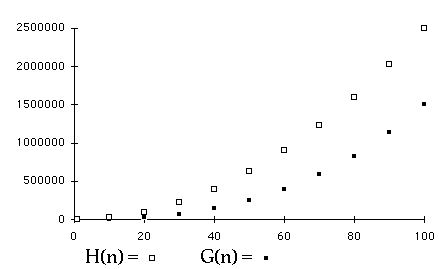 Plotting ComplexityEngineers Method (Modified)
Plotting ComplexityEngineers Method (Modified)
Let
 then
then
-

Let b = 2 and
 then
then
-

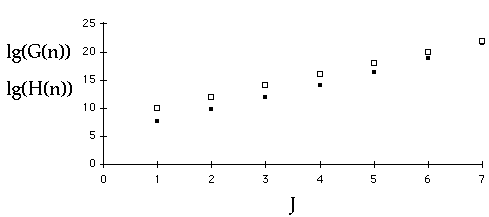 Plotting ComplexityTransform the Axis
Plotting ComplexityTransform the Axis
Let
 and
and
 (or
(or
 )
then:
)
then:
g(J) = f(
 )
= a(
)
= a(
 )k
= aJ
)k
= aJ
So g(J) is linear!
Example
n f(n) =5n*n+n + 3 J=n*n
1 9 1
10 513 100
20 2023 400
30 4533 900
40 8043 1600
50 12553 2500
60 18063 3600

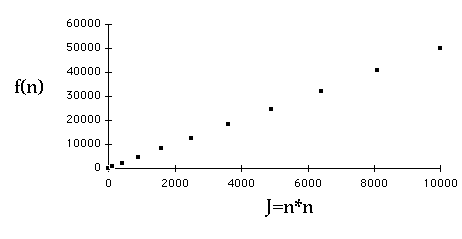 Which is Quadratic?
Which is Quadratic?
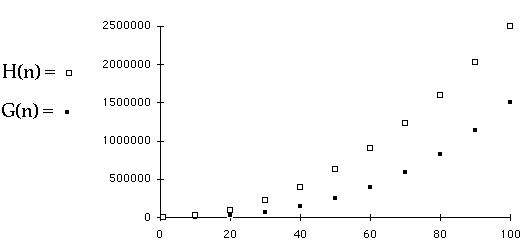
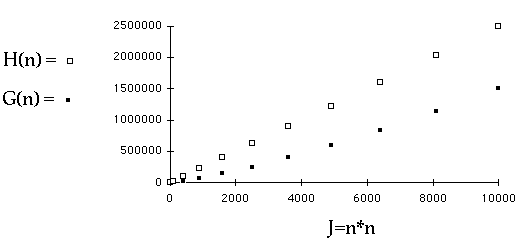
Bubble sort worst case is
 (
n*n )
(
n*n )
Complexity is an*n + bn + c
Timing Results Worst Case
N Bubble Sort
400 20
500 31
600 45
700 61
800 79
Least Squares fit of data to an*n + bn + c
Bubble sort worst case is 0.0001143n*n + 0.01084n - 2.738
Predicted vs. Actual Time for Bubble Sort
N Actual Predicted % Error
900 105 99.601 5.14%
1000 124 122.402 1.29%
1100 149 147.489 1.01%
2000 496 476.142 4.00%
2400 713 681.646 4.40%
 CS 660: Combinatorial Algorithms
CS 660: Combinatorial Algorithms CS 660: Combinatorial Algorithms
CS 660: Combinatorial Algorithms